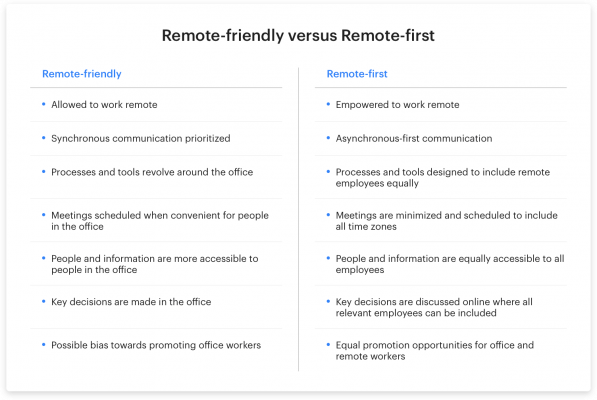Think you haven’t really figured this remote work thing out yet? Fret not, you’re in good “company”: along with Twitter, Shopify, Amazon, Facebook, Coinbase, and thousands of other organizations finding themselves working remotely with little skills or experience and no emergency work-from-home policy.
Some are thriving with the transition, while others can’t wait to get back to the office. Historically, remote work experiments have either succeeded wildly or failed miserably.1 But going forward, most companies won’t have a choice but to learn to do it right, even if they’re hesitant to continue with remote work post-pandemic.
Why? Three quarters of remote employees aren’t emotionally ready to return to offices post pandemic.2 Millennials are clear that they want more flexibility going forward.3
Matt Mullenweg, CEO of Automattic, predicts that “…90% of all the companies that are going to be changing the course of the world are going to function (in distributed teams). They will evolve to be distributed first, or they’ll be replaced by those that are.”4
And it might not be far from the truth. WordPress, a product of Automattic, powers a third of the internet. It’s also been fully remote since its inception more than 15 years ago. Incredible, but possible.
Companies like Automattic know something that others don’t. They’ve mastered the very things that make remote work so attractive to employees—work-life balance, autonomy, motivation, and so much more—and they’ve been acing it for years before the pandemic began. So what makes them tick?
In this article, we’ll take a look at six companies that have been successfully remote (either totally or partially) since the pandemic and see what your small business can take away from their success stories:
- Doist: Think “remote-first,” not “remote-friendly”
- GitLab: Think handbook-first
- Automattic: Organize wildly amazing company meetups
- Zapier: The art of distributed decision making
- ghSMART: Hire rigorously
- Mattermost: CEO listening tours
- Sticker Mule: Onboard remote employees efficiently
- Collage.com: Encourage vulnerability to build trust
- Acceleration Partners: Make the most of face-to-face time
Don’t feel like reading? Here’s a quick clip on the best remote teams that are doing it right:
1. Doist
Doist is a tech company that makes ToDoist, a productivity app used by over 25 million people around the world, and Twist, a communication tool. It’s been remote for over 10 years since it began, with employees from over 25+ countries.
Lesson to steal: Think remote-first, not remote friendly
Doist considers itself to be a “remote-first,” not merely a “remote-friendly,” company. Here’s the difference: in a remote-friendly team, remote work is often considered “incidental” and the policies and processes in place are often structured this way.5
Sometimes a work-from-home policy simply adapts rules from the standard employee handbook to remote workers. This can lead to a dissonance in the way remote work, well, works and the rules in place to structure it. For instance, quarterly meetings might make sense for an on-site sales team—but might not be consistent enough for a distributed team.
In a remote-first team, all the processes, remote working tools, and communication channels should center around remote workers and the unique demands remote work places upon individuals and teams.
ToDoist documents all internal communication and codifies workflows so everyone’s on the same page, no matter where in the world they’re tuning in from.
2. GitLab
Founded in 2011, GitLab is a DevOps platform that claims to be the largest all-remote workforce in the world, the diversity of which it considers to be a competitive advantage.
Lesson to steal: Think handbook-first
GitLab’s handbook is a unique artifact. It’s a live, constantly updating document that takes the discipline of every individual in the company to build. It provides guidelines on how to collaborate, onboard new people, and think collectively, much like a good WFH policy. Each and every employee has the chance to shape the handbook by suggesting edits.
Typically, new changes are announced over messaging platforms like the RingCentral app or Slack. At GitLab, the insistence is on taking an extra step and updating the handbook. While it’s a slower process, it improves team accountability. GitLab co-founder and CEO Sid Sijbrandij believes it allows people to commit to and build upon a change more concretely.7
3. Automattic
As mentioned earlier, Automattic created WordPress, which powers 33% of the internet. While it’s been remote for 15 years, annual team meetups are a big part of its culture.
Lesson to steal: Organize wildly amazing company meetups
Automattic hosts a (usually) week-long company-wide training camp at least once a year. There is a mix of work and leisure: information sharing and Q&A sessions by management and various teams, skill-improvement masterclasses, and project work. Keynote speakers like author Cheryl Strayed and Good Morning America’s Dan Harris have also made an appearance at these meetups.
It’s where employees of the company socialize and get to know one another, building strong interpersonal relationships.8 Does this really help make up for the remaining 51 weeks of isolation? Yes. And they’ve got the data to prove it.9
4. Zapier
Zapier has been remote since before it was officially Zapier: the co-founders created it while juggling their school and work commitments and rarely met, though they lived in the same city.
Now, it’s the hottest name in productivity, making task automation and workflow automation accessible to non-technical folks.
Lesson to steal: The art of distributed decision making
There’s one thing that both co-located and remote teams could benefit from speeding up, and that’s team decision making.
Zapier’s distributed teams use a framework called Driver, Approver, Consulted, and Informed, or DACI. These are roles attributed to anyone involved in a decision: a “driver” is responsible for driving the work and collecting the relevant data; an “approver” is responsible for giving the go-ahead; “consultants” provide expert opinions; and finally the “informed” are those whose work is impacted by the outcome of the decision making.10 This establishes accountability, so employees easily understand who’s taking the lead on a project and feel free to ignore project updates if they’re not assigned to any role.11
Atlassian, the company behind the workflow management tool Trello, also uses the DACI framework, documenting the considerations, relevant research, trade-offs, and recommendations that go into the decision, for better transparency.12
5. ghSMART
Founded in 1995, ghSMART is a management consulting company that’s always had a completely remote team. As of 2017, more than 80% of their work was done by teams operating out of their home offices.13
Lesson to steal: Hire rigorously
Many teams around the world are new-ish to remote working. As companies around the world are learning and getting used to virtual meetings, workers need special skills to excel and thrive in remote environments. Employees need to be competent communicators, empathetic collaborators and independent workers. Sometimes, interviewers don’t get to meet their potential hires in person. So it makes sense that companies pay special attention to whom they hire for remote roles.
ghSMART does not skimp on recruitment. Aside from assigning handsome budgets to pay top talent (and referral bounties of up to 100K), leaders spend up to 42 hours researching and interviewing a given candidate. At interviews, candidates are given detailed insight into the company’s finances, strategy, individual consultant performance, and implications on compensation.14
Every candidate goes through at least one, rigorous interview of up to three hours long and is asked detailed questions about every single job they’ve held up to that point.15
6. Mattermost
Mattermost is an open source messaging platform that facilitates secure team collaboration. Most of its team works remotely. Mattermost software is used by thousands of organizations around the world in 16 languages.
Lesson to steal: CEO listening tours
A lot of companies face problems with employee engagement, and this is common to both remote and colocated teams. With everyone being geographically distant, CEOS and top brass can sometimes be disconnected from the rest of the company. It’s important for companies to always keep listening, and Mattermost does this through one-on-ones with managers, regular pulse and engagement surveys, anonymous feedback, and CEO Listening Tours.16
Here’s how a Listening Tour goes: Different groups of about 5-8 staff meet via video call for about half an hour, excluding the managers. The CEO drops in on these calls, and takes notes while employees speak about their thoughts, concerns, and feedback. Once this is done, he shares his learnings separately with the managers, who then process it for implementation.
Learn about the best video conferencing software for small businesses.
7. Sticker Mule
Sticker Mule is a printing company that ships custom stickers, labels, magnets, buttons, packaging, and more, to a clientele of big brand names worldwide. It has a remote team spread across 17 countries.
Lesson to steal: Onboard remote employees efficiently
Sticker Mule’s onboarding process exists as a checklist copied into a project on Asana (their project management tool) for every new hire.
The hire is introduced to the metrics and systems relevant to them, given the lowdown on Sticker Mule’s overall strategic priorities, and introduced to coworkers as soon as they begin. All this happens without skipping a beat—new hires are assimilated immediately into the work routine.
They’re assigned at least a few weeks of work and a task list on Asana as soon as they start working, to avoid that lull that so often occurs at the beginning of new jobs.17
Want more WFH tips? Download the Remote Work Checklist.
8. Collage.com
Collage.com, which makes photo merchandise, has been a fully remote workforce since it began. Having grown from an annual revenue of $4 to $50 million in the seven years since its inception, it has the honor of being the first all-remote company to be profiled in an HBR case study.18
Lesson to steal: Encourage vulnerability to build trust
One of the biggest critiques of remote work is that it’s not conducive to building close-knit, highly collaborative teams. (Here are a few virtual team building activities that can help.) But trust can be built over geographical boundaries, and how Collage.com does it is by encouraging vulnerability.
Managers are encouraged to share when they make mistakes, big or small. They’re encouraged to discuss the problems they’re facing with their subordinates and also perform retrospectives and post-mortems on past issues.
“Management should contribute something they could have done to prevent problems, such as establishing better processes, setting more clear responsibilities, or fixing underlying problems in systems that allow mistakes to happen,” writes co-founder Kevin Borders.19
At Monday meetings, discussions about colleagues’ personal lives are normalized and so are deep conversations sometimes in the middle of the night. It might be true that “there’s no replacement for face-to-face” but a lot of the foundations of strong relationships can easily be built across time zones, if only people are willing to put in the effort.
9. Acceleration Partners
Acceleration Partners (AP) is an award-winning global partner marketing agency. With a diverse, multicultural team, it serves brands around the world and was voted Best Place to Work by Glassdoor two years in a row.20
Lesson to steal: Make the most of face-to-face time
AP organizes most of the company into “hubs”—cities where employees working from home reside relatively near one another—and then encourages them to meet up on occasional “work together days,” social events, and in-person training.
General Manager Matt Wool makes it a point to travel to each hub at least twice a year. He writes “I’ve found this allows me to have meaningful interactions with pretty much everyone in the company and maintain important personal connections. If not for these hub visits, many valuable feedback points might never have made their way to the leadership level.”21
Before each visit, teams drum up enthusiasm through video conference calls, where every member is present.
These meetups aren’t always about work. They usually begin with laid-back gatherings over a meal or drinks, where colleagues can loosen up and share in a group, in a more intimate setting than a stiff conference room.
Learn more about time management tips for remote employees.
The one thing every successful remote company does
It goes without saying that every company is different. What worked for one company under a very specific set of circumstances (pre-pandemic), might not work as readily for your company.
But it’s worth noting that in spite of how differently each company might have approached remote work, the one thing that recurs is this: Great remote companies have high standards of clarity and consistency in team communication. They treat remote work as a new way of working, not a lesser form of co-located employment.
If individuals are the building blocks of an organization, collaboration is the glue that holds it together.
Keen on building the next great remote company? Start with communication.
1 hbr.org/2015/03/why-remote-work-thrives-in-some-companies-and-fails-in-others
2 forbes.com/sites/jackkelly/2020/05/24/the-work-from-home-revolution-is-quickly-gaining-momentum/#61d7fa651848
3 nytimes.com/2019/09/17/style/generation-z-millennials-work-life-balance.html
4 ted.com/talks/matt_mullenweg_why_working_from_home_is_good_for_business/transcript?language=en&referrer=playlist-the_way_we_work
5 doist.com/blog/lessons-remote-companies/
6 about.gitlab.com/blog/2020/03/06/resources-for-companies-embracing-remote-work/
7 about.gitlab.com/handbook/handbook-usage/#why-handbook-first
8 news.yahoo.co.jp/byline/yatsuzukaeri/20180813-00092521/
9 data.blog/2017/04/12/welcoming-new-colleagues-a-data-based-story/
10 hbr.org/2020/05/the-key-to-building-a-successful-remote-organization-data
11 medium.com/better-programming/zapiers-vp-of-engineering-shares-15-tips-for-managing-remote-teams-6fe530634cd2
12 atlassian.com/team-playbook/plays/daci
13 about.gitlab.com/handbook/handbook-usage/#why-handbook-first
14 hbr.org/2017/02/what-20-years-as-a-remote-organization-has-taught-us-about-managing-remote-teams
15 hbr.org/2008/12/seven-steps-to-smarter-hiring
16 handbook.mattermost.com/operations/operations/company-cadence
17 blog.hubstaff.com/how-stickermule-team-onboards-new-hires/
18 hbs.edu/faculty/Pages/item.aspx?num=51578
19 medium.com/swlh/the-secret-to-building-trust-in-an-all-remote-startup-8a7da79bfeba
20 careers.accelerationpartners.com
21 glassdoor.com/employers/blog/keeping-remote-cultures-strong-face-face-meetings
Originally published Jul 13, 2020, updated Jan 30, 2023







